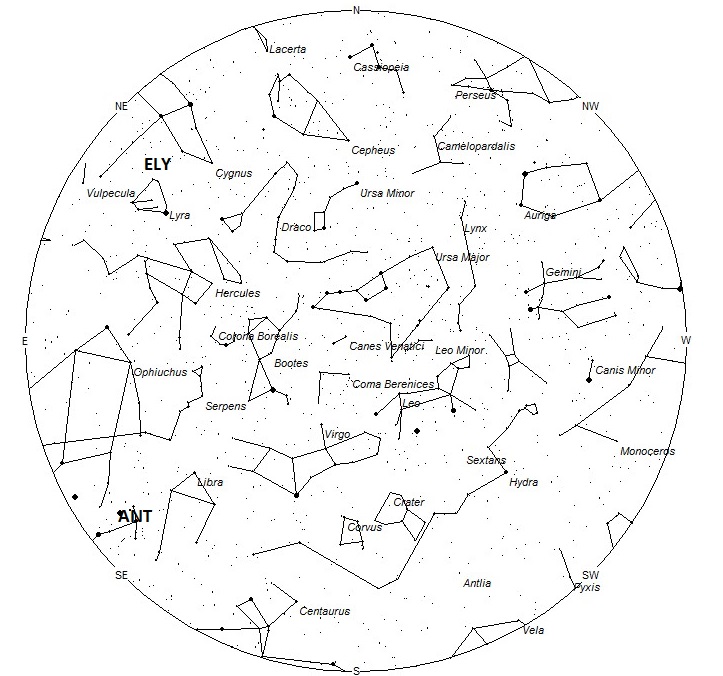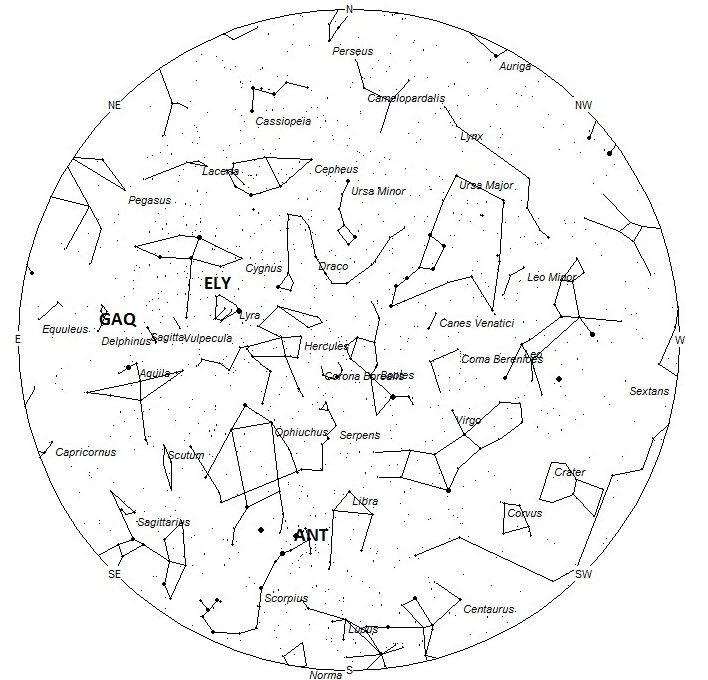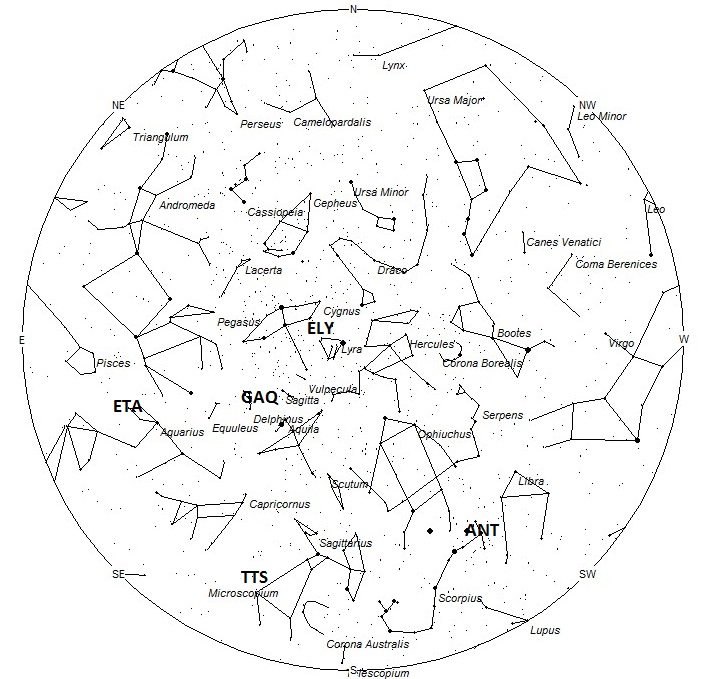Radiant Positions at 4am Local Summer Time
During this period the moon reaches its first quarter phase on Friday May 13th. On that date the moon will be located 90 degrees east of the sun and will set near 0200 local summer time (LST) for most locations in the mid-northern latitudes. This weekend the slender waxing crescent moon will pose no problems for meteor observers. It will set during the late evening hours allowing the more active morning hours to be free of interfering moonlight. The estimated total hourly meteor rates for evening observers this week is near 3 for observers located in the northern hemisphere and 4 for observers located south of the equator. For morning observers the estimated total hourly rates should be near 15 as seen from mid-northern latitudes (45N) and 25 as seen from tropical southern locations (25S). The actual rates will also depend on factors such as personal light and motion perception, local weather conditions, alertness and experience in watching meteor activity. Note that the hourly rates listed below are estimates as viewed from dark sky sites away from urban light sources. Observers viewing from urban areas will see less activity as only the brightest meteors will be visible from such locations.
The radiant (the area of the sky where meteors appear to shoot from) positions and rates listed below are exact for Saturday night/Sunday morning May 7/8. These positions do not change greatly day to day so the listed coordinates may be used during this entire period. Most star atlases (available at science stores and planetariums) will provide maps with grid lines of the celestial coordinates so that you may find out exactly where these positions are located in the sky. A planisphere or computer planetarium program is also useful in showing the sky at any time of night on any date of the year. Activity from each radiant is best seen when it is positioned highest in the sky, either due north or south along the meridian, depending on your latitude. It must be remembered that meteor activity is rarely seen at the radiant position. Rather they shoot outwards from the radiant so it is best to center your field of view so that the radiant lies at the edge and not the center. Viewing there will allow you to easily trace the path of each meteor back to the radiant (if it is a shower member) or in another direction if it is a sporadic. Meteor activity is not seen from radiants that are located far below the horizon. The positions below are listed in a west to east manner in order of right ascension (celestial longitude). The positions listed first are located further west therefore are accessible earlier in the night while those listed further down the list rise later in the night.
These sources of meteoric activity are expected to be active this week.
The center of the large Anthelion (ANT) radiant is currently located at 16:00 (240) -21. This position lies in western Scorpius, 3 degrees north of the 2nd magnitude star known as Dschubba (delta Scorpii). Due to the large size of this radiant, Anthelion activity may also appear from the nearby constellations of Libra, northern Lupus, and southern Ophiuchus as well as Scorpius. This radiant is best placed near 0200 local LST, when it lies on the meridian and is located highest in the sky. Hourly rates at this time should be near 2 as seen from mid-northern latitudes and 3 as seen from tropical southern latitudes. With an entry velocity of 30 km/sec., the average Anthelion meteor would be of slow velocity.
The Eta Lyrids (ELY) are active from May 5-12 with maximum activity occurring on the 10th. The radiant is currently located at 19:23 (291) +43. This area of the sky is located in northeastern Lyra, 4 degrees northeast of the 4th magnitude star known as eta Lyrae. This radiant is best placed during the last hour before dawn when it lies highest above the horizon in a dark sky. Current rates are expected to be near 2 per hour as seen during the morning hours from the northern hemisphere. These meteors are not well seen from locations south of the equator. With an entry velocity of 43 km/sec., the average meteor from this source would be of medium velocity.
The Theta 2 Sagittariids (TTS) are a new discovery of the IMO video network using cameras active in Australia. These meteors are active from May 9-14, which maximum activity occurring on the 13th. The radiant lies near the position of 19:40 (295) -34. This area of the sky lies in a rather blank area of southeastern Sagittarius, 4 degrees northeast of the 4th magnitude star Theta 2 Sagittarii. The radiant is best placed just before the break of dawn when the radiant lies highest in the sky. While Theta 2 Sagittariid meteors can be seen in both hemispheres, the south is favored as the radiant lies higher in their sky. Hourly rates are expected to be less than 1 no matter your location. At 67km/sec. the Theta 2 Sagittariids would produce meteors of swift velocity.
The Gamma Aquiliids (GAQ) were discovered by members of the Croatian Meteor Network (Željko Andreić at al.) These meteors are active from May 5-12 with maximum activity occurring on the 8th The radiant is currently located at 20:28 (307) +15. This area of the sky is actually located in western Delphinus, just 2 degrees west of the 4th magnitude star known as Rotanev (beta Delphini). This radiant is best placed during the last hour before dawn when it lies highest above the horizon in a dark sky. Current rates are expected to be less than 1 per hour as seen during the morning hours. these meteors can be seen equally well from both hemispheres. With an entry velocity of 66 km/sec., the average meteor from this source would be of swift velocity.
The Eta Aquariids (ETA) are particles from Halley’s Comet, produced in Earth-crossing orbits many centuries ago. We pass closest to these orbits from May 5 through the 9th. During this period the Eta Aquariids are at their best, capable of producing zenith hourly rates (ZHRs) of 60. The actual visible rates are most often less than half this figure due to the low altitude of the radiant at dawn. Observed hourly rates at maximum normally vary from zero at 60 degrees north latitude to 30 near the equator and back down to near zero again in Antarctica, where the radiant elevation is again very low. Hourly rates this weekend will most likely be 5-10 per hour as seen from mid-northern latitudes. The radiant is currently located at 22:39 (340) +00. This area of the sky is located in northern Aquarius, just 1 degree east of the position occupied by the fourth magnitude star known as Hydria (eta Aquarii). The best time to view this activity is during the hour before the start of morning twilight, when the radiant lies highest in a dark sky. With the radiant low in the east it would be best to face halfway up in the sky in that same direction. If the radiant has sufficient altitude Eta Aquariid meteors can also be seen shooting down toward the eastern horizon. With an entry velocity of 67 kilometers per second, a majority of these meteors will appear to move swiftly with a high percentage of the bright meteors leaving persistent trains. Surprisingly, this shower produces very few fireballs.
As seen from the mid-northern hemisphere (45N) one would expect to see approximately 5 sporadic meteors per hour during the last hour before dawn as seen from rural observing sites. Evening rates would be near 2 per hour. As seen from the tropical southern latitudes (25S), morning rates would be near 9 per hour as seen from rural observing sites and 3 per hour during the evening hours. Locations between these two extremes would see activity between the listed figures.
The list below offers the information from above in tabular form. Rates and positions are exact for Saturday night/Sunday morning except where noted in the shower descriptions.
| SHOWER | DATE OF MAXIMUM ACTIVITY | CELESTIAL POSITION | ENTRY VELOCITY | CULMINATION | HOURLY RATE | CLASS |
| RA (RA in Deg.) DEC | Km/Sec | Local Daylight Saving Time | North-South | |||
| Anthelions (ANT) | – | 16:00 (240) -21 | 30 | 02:00 | 2 – 3 | II |
| eta Lyrids (ELY) | May 10 | 19:23 (291) +43 | 43 | 05:00 | 2 – <1 | II |
| theta 2 Sagittariids (TTS) | May 13 | 19:40 (295) -34 | 67 | 05:00 | <1 – <1 | IV |
| gamma Aquilids (GAQ) | May 08 | 20:28 (307) +15 | 66 | 06:00 | <1 – <1 | IV |
| eta Aquariids (ETA) | May 07 | 22:39 (340) +00 | 67 | 08:00 | 5 – 15 | I |




